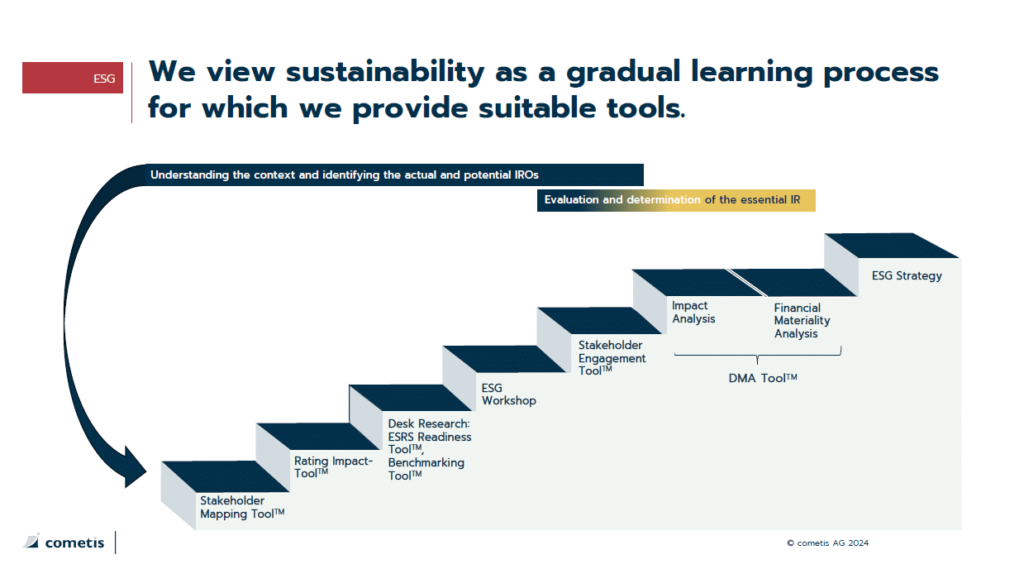Materiality Analysis
The Double Materiality: Your Key to Managing the Complexity of CSRD and ESRS
The requirements of the Corporate Sustainability Reporting Directive (CSRD) and the European Sustainability Reporting Standards (ESRS) present companies with complex challenges, particularly when it comes to double materiality analysis. Contrary to the notion that this analysis is simple and quickly done, the ESRS requirements are extensive and necessitate a fundamental review of current practices. Companies face multi-layered tasks that require specific know-how and new methods. A holistic perspective and an understanding of diverse cause-effect relationships are essential.
The Global ESG Monitor DMA (Double Materiality)-ToolTM reduces complexity and provides assistance and data where company-specific information is lacking.
Our specially developed tool supports companies in systematically screening and assessing business models, value chains, and strategies. It offers guidance, data, and references where knowledge and experience are lacking. Through a structured, computer-based approach, an ESRS-compliant, audit-proof, and well-documented process is ensured.
The tool enables maximum flexibility: Topics can be worked on individually or in teams. Workshops and expert groups from various departments can conduct the analysis in whole or in part. The screening includes the systematic examination of business models, value chains, and strategies on multiple levels – from topics to sub-topics down to detailed sub-sub-topics. This includes the identification of impacts, risks, and opportunities. The clear separation between the guided screening of corporate activities along the value chain and the materiality assessment ensures transparency and traceability for all involved.
Use the double materiality analysis as a strategic tool that efficiently provides insights and enables prioritization. It not only strengthens your ESG performance but also promotes your economic strength and resilience.
Deploy the double materiality analysis in a targeted manner to sustainably manage and increase your corporate value. Effectively integrate environmental, social, and governance aspects into your business strategy. Through the well-founded assessment of your impacts on the environment and society, as well as the influences of external sustainability topics on your business model, you can systematically identify opportunities and risks. Use these insights for strategic decisions and strengthen the resilience and responsibility of your company.

Benefits of materiality analysis:
- Focus and relief: Defining the curriculum for reporting and focusing all required resources.
- Comprehensive risk and opportunity management, high-quality due diligence process: Expansion of classic risk and opportunity management to include sustainability-related categories
- Unlocking potentials: Systematic utilization of opportunities arising from the transition to a sustainable economy
- Image enhancement and avoidance of reputational risks: Control over stakeholder dialogue through needs-based addressing of stakeholders and contextualization of information
Become CSRD/ESRS compliant – systematically and without false promises. Book your demo appointment for our tool here.
Discover our other tools as well:
- Stakeholder Mapping Tool
- Stakeholder Engagement Tool
- Rating Impact Tool
- ESRS Readiness Reporting Tool
Q&A – Double Materiality Analysis
Q: How long does it take to conduct a materiality analysis?
A: The duration of a materiality assessment can vary significantly and depends on various factors, such as the complexity of the business model, the size of the company, and the number and depth of sustainability topics to be analyzed. As a rule, conducting a thorough materiality analysis can take several months. Our Global ESG Monitor DMA (Double Materiality)-ToolTM can help you carry out this process not only effectively but also efficiently, so that you can complete your materiality analysis in just a few weeks.
Q: Do I need to involve my stakeholders in the materiality analysis? How do I know who to involve?
A: Yes, engaging stakeholders is a crucial part of the materiality assessment process. Stakeholders can be any individuals affected by the company’s business activities or who have an interest in its sustainability practices, such as employees, customers, suppliers, local communities, and investors. To determine which stakeholders to include, consider who is most impacted by your company’s activities and who might have valuable insights into your sustainability impacts and risks.
Q: Why is it important to conduct a double materiality analysis?
A: Conducting a double materiality assessment is important because it determines both the company’s impacts on the environment and society (impact materiality) and the impacts of environmental and social issues on the company’s financial performance (financial materiality). This comprehensive and structured approach helps companies identify and prioritize material sustainability topics that are crucial not only for ethical business conduct but also for long-term financial performance.

